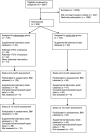A primary care-based, multicomponent lifestyle intervention for overweight adolescent females
- PMID: 22331335
- PMCID: PMC3289521
- DOI: 10.1542/peds.2011-0863
A primary care-based, multicomponent lifestyle intervention for overweight adolescent females
Abstract
Background and objective: Most clinic-based weight control treatments for youth have been designed for preadolescent children by using family-based care. However, as adolescents become more autonomous and less motivated by parental influence, this strategy may be less appropriate. This study evaluated a primary care-based, multicomponent lifestyle intervention specifically tailored for overweight adolescent females.
Methods: Adolescent girls (N = 208) 12 to 17 years of age (mean ± SD: 14.1 ± 1.4 years), with a mean ± SD BMI percentile of 97.09 ± 2.27, were assigned randomly to the intervention or usual care control group. The gender and developmentally tailored intervention included a focus on adoptable healthy lifestyle behaviors and was reinforced by ongoing feedback from the teen's primary care physician. Of those randomized, 195 (94%) completed the 6-month posttreatment assessment, and 173 (83%) completed the 12-month follow-up. The primary outcome was reduction in BMI z score.
Results: The decrease in BMI z score over time was significantly greater for intervention participants compared with usual care participants (-0.15 in BMI z score among intervention participants compared with -0.08 among usual care participants; P = .012). The 2 groups did not differ in secondary metabolic or psychosocial outcomes. Compared with usual care, intervention participants reported less reduction in frequency of family meals and less fast-food intake.
Conclusions: A 5-month, medium-intensity, primary care-based, multicomponent behavioral intervention was associated with significant and sustained decreases in BMI z scores among obese adolescent girls compared with those receiving usual care.
Trial registration: ClinicalTrials.gov NCT01068236.
Figures
Comment in
-
Pediatrics: tailoring weight-control programs to teenagers.Nat Rev Gastroenterol Hepatol. 2012 Mar 6;9(4):187. doi: 10.1038/nrgastro.2012.42. Nat Rev Gastroenterol Hepatol. 2012. PMID: 22392298 No abstract available.
Similar articles
-
Comparison of parent-only vs family-based interventions for overweight children in underserved rural settings: outcomes from project STORY.Arch Pediatr Adolesc Med. 2008 Dec;162(12):1119-25. doi: 10.1001/archpedi.162.12.1119. Arch Pediatr Adolesc Med. 2008. PMID: 19047538 Free PMC article. Clinical Trial.
-
Family Weight School treatment: 1-year results in obese adolescents.Int J Pediatr Obes. 2008;3(3):141-7. doi: 10.1080/17477160802102475. Int J Pediatr Obes. 2008. PMID: 18608623 Clinical Trial.
-
Behavioral weight control for overweight adolescents initiated in primary care.Obes Res. 2002 Jan;10(1):22-32. doi: 10.1038/oby.2002.4. Obes Res. 2002. PMID: 11786598 Clinical Trial.
-
Offspring body size and metabolic profile - effects of lifestyle intervention in obese pregnant women.Dan Med J. 2014 Jul;61(7):B4893. Dan Med J. 2014. PMID: 25123127 Review.
-
Impact of Game-Based Health Promotion Programs on Body Mass Index in Overweight/Obese Children and Adolescents: A Systematic Review and Meta-Analysis of Randomized Controlled Trials.Child Obes. 2018 Feb/Mar;14(2):67-80. doi: 10.1089/chi.2017.0250. Epub 2017 Nov 29. Child Obes. 2018. PMID: 29185787
Cited by
-
Exploring the Role of Family Functioning in the Association Between Frequency of Family Dinners and Dietary Intake Among Adolescents and Young Adults.JAMA Netw Open. 2018 Nov 2;1(7):e185217. doi: 10.1001/jamanetworkopen.2018.5217. JAMA Netw Open. 2018. PMID: 30646382 Free PMC article.
-
Weight loss interventions for overweight and obese adolescents: a systematic review.Eat Weight Disord. 2017 Jun;22(2):211-229. doi: 10.1007/s40519-016-0309-1. Epub 2016 Aug 19. Eat Weight Disord. 2017. PMID: 27542161
-
A systematic review and narrative synthesis of interventions for uncomplicated obesity: weight loss, well-being and impact on eating disorders.J Eat Disord. 2017 May 1;5:15. doi: 10.1186/s40337-017-0143-5. eCollection 2017. J Eat Disord. 2017. PMID: 28469914 Free PMC article. Review.
-
Do Overweight Adolescents Adhere to Dietary Intervention Messages? Twelve-Month Detailed Dietary Outcomes from Curtin University's Activity, Food and Attitudes Program.Nutrients. 2015 Jun 2;7(6):4363-82. doi: 10.3390/nu7064363. Nutrients. 2015. PMID: 26043035 Free PMC article. Clinical Trial.
-
Management of cardiovascular disease risk in teens with type 1 diabetes: Perspectives of teens with and without dyslipidemia and parents.Pediatr Diabetes. 2019 Mar;20(2):210-216. doi: 10.1111/pedi.12771. Pediatr Diabetes. 2019. PMID: 30209870 Free PMC article.
References
-
- Ogden CL, Carroll MD, Curtin LR, Lamb MM, Flegal KM. Prevalence of high body mass index in US children and adolescents, 2007-2008. JAMA. 2010;303(3):242–249 - PubMed
-
- Cook S, Weitzman M, Auinger P, Nguyen M, Dietz WH. Prevalence of a metabolic syndrome phenotype in adolescents: findings from the third National Health and Nutrition Examination Survey, 1988-1994. Arch Pediatr Adolesc Med. 2003;157(8):821–827 - PubMed
-
- Mossberg HO. 40-Year follow-up of overweight children. Lancet. 1989;2(8661):491–493 - PubMed
-
- Must A, Jacques PF, Dallal GE, Bajema CJ, Dietz WH. Long-term morbidity and mortality of overweight adolescents. A follow-up of the Harvard Growth Study of 1922 to 1935. N Engl J Med. 1992;327(19):1350–1355 - PubMed
-
- Srinivasan SR, Bao W, Wattigney WA, Berenson GS. Adolescent overweight is associated with adult overweight and related multiple cardiovascular risk factors: the Bogalusa Heart Study. Metabolism. 1996;45(2):235–240 - PubMed



